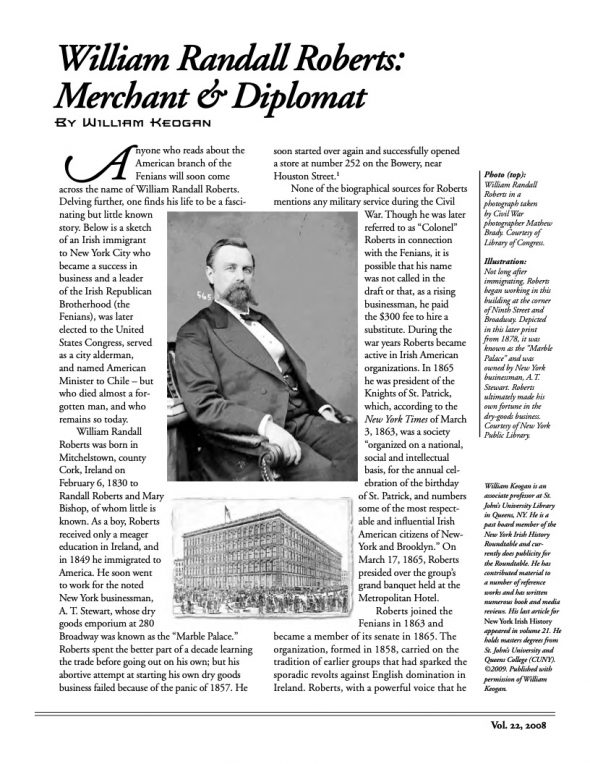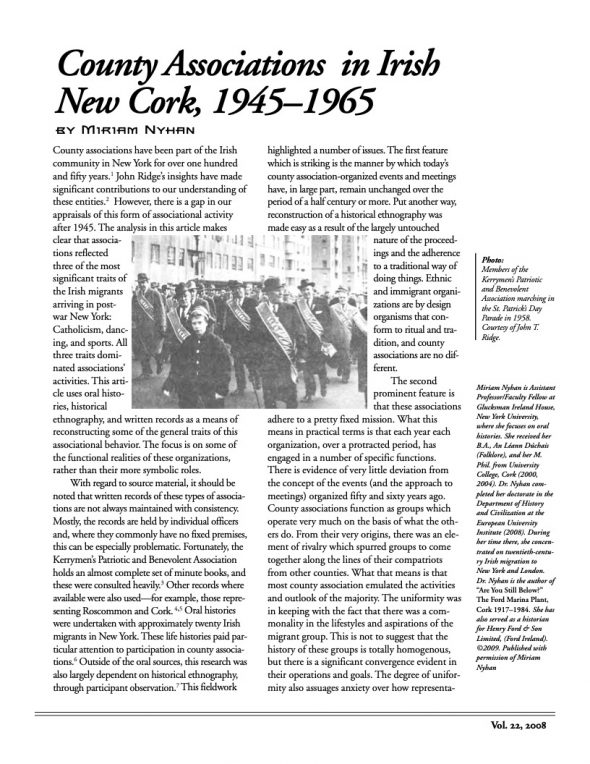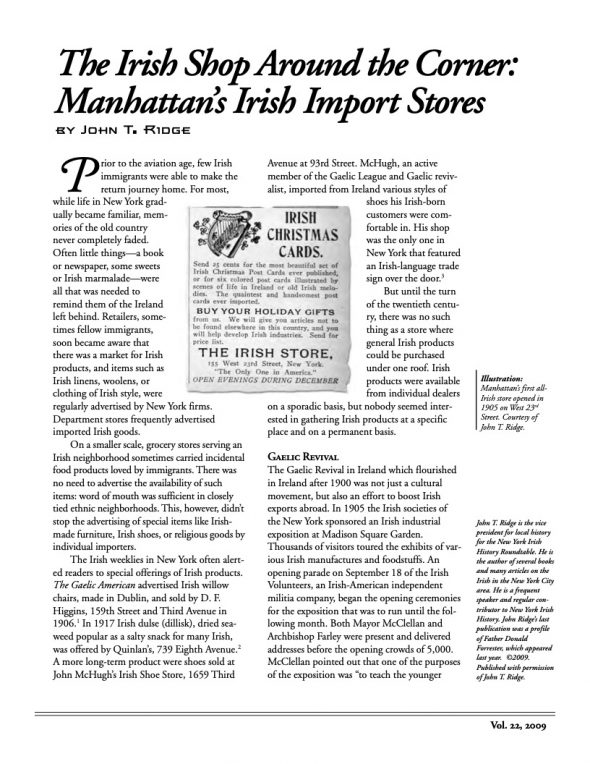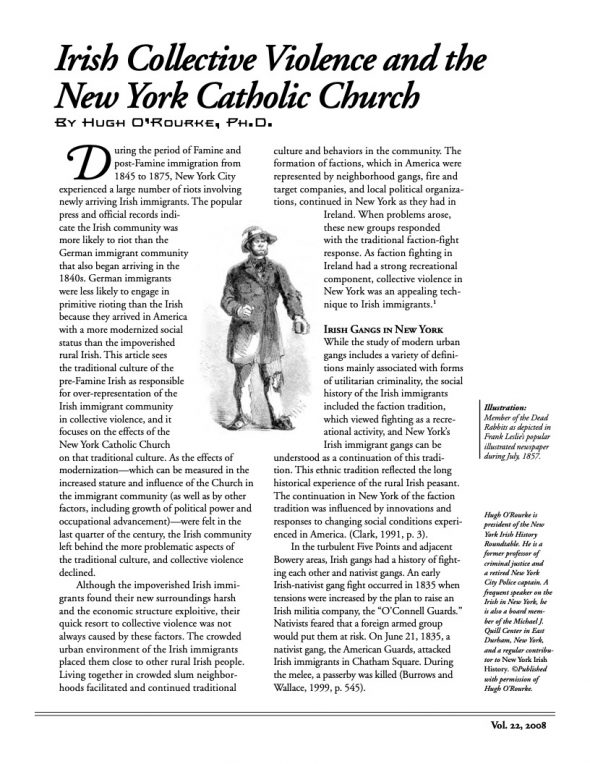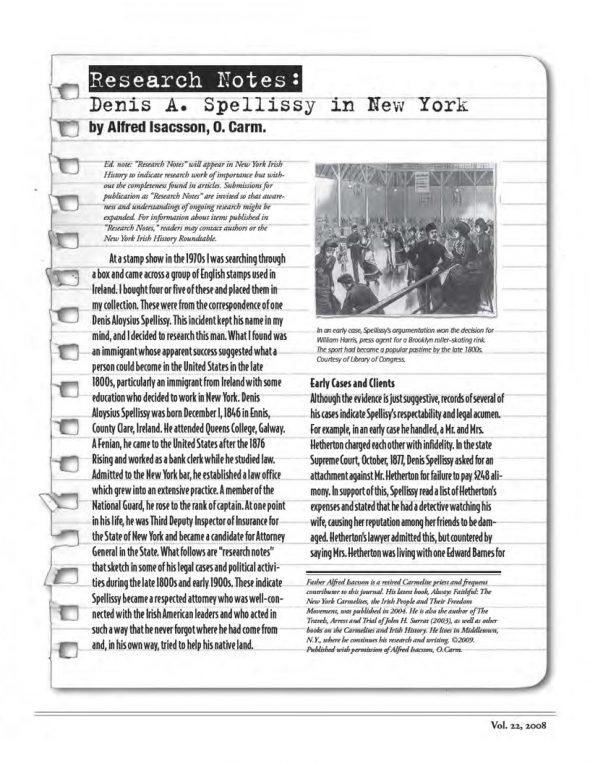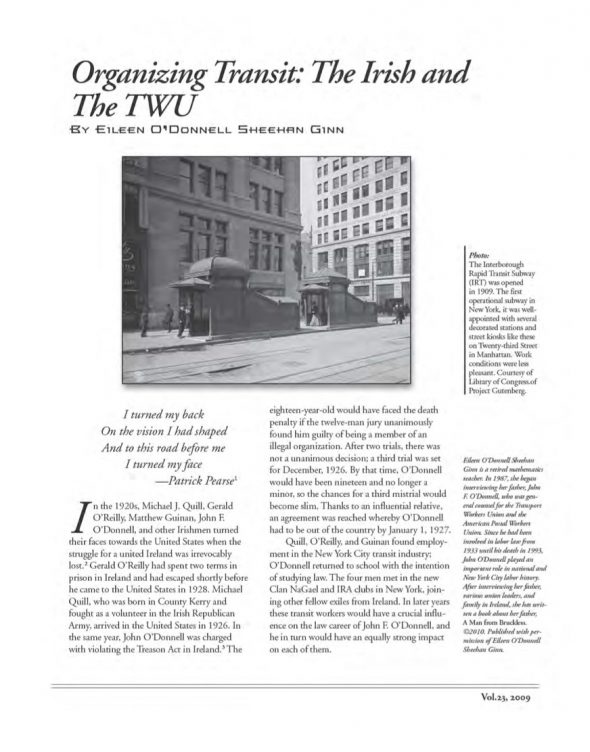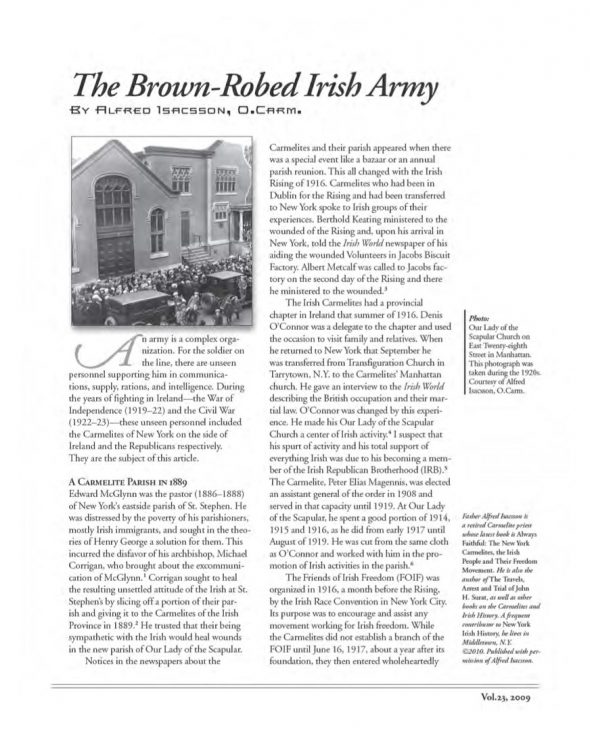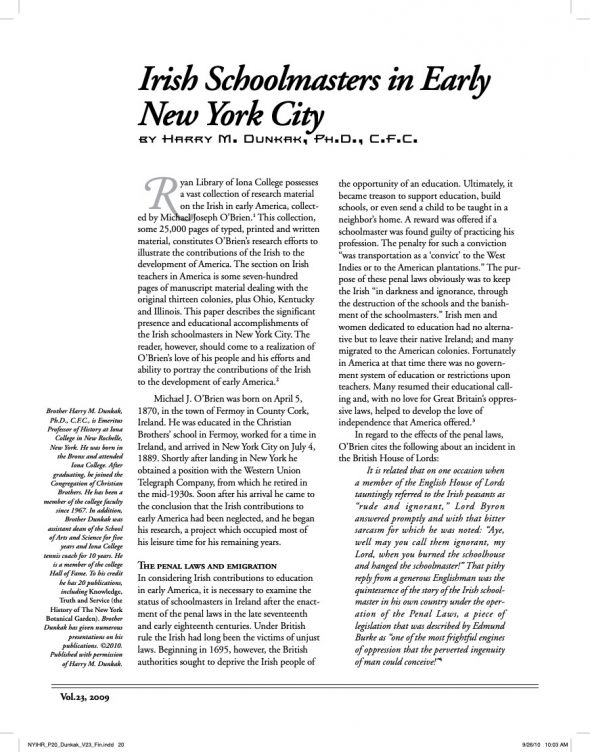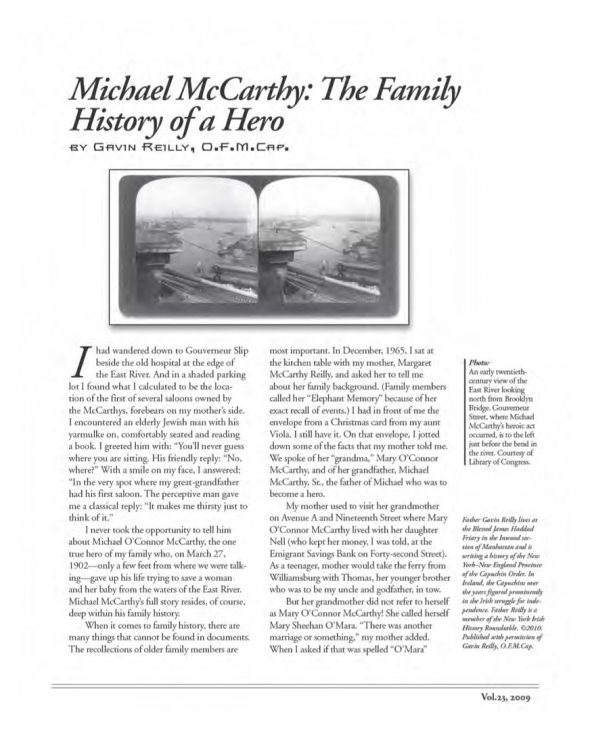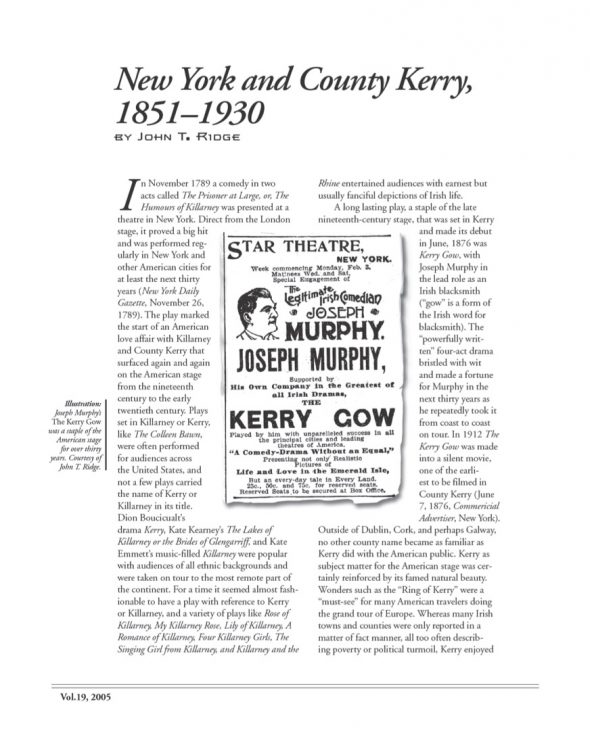New York Irish History Roundtable - Journal Articles
William Randall Roberts - Merchant and Diplomat
Author: William Keogan
Publication Year: 2008
Journal Volume: 22
Article Reference: NYIHR-V22-02
Anyone who reads about the American branch of the Fenians will soon come across the name of William Randall Roberts. Delving further, one finds his life to be a fasci - nating but little known story. Below is a sketch of an Irish immigrant to New York City who became a success in business and a leader of the Irish Republican Brotherhood (the Fenians), was later elected to the United States Congress, served as a city alderman, and named American Minister to Chile - but who died almost a for - gotten man, and who remains so... [Read Full Article]
County Associations in Irish New York, 1945–1965
Author: Miriam Nyhan, Ph.D.
Publication Year: 2008
Journal Volume: 22
Article Reference: NYIHR-V22-03
County associations have been part of the Irish community in New York for over one hundred and fifty years. John Ridge's insights have made significant contributions to our understanding of these entities. However, there is a gap in our appraisals of this form of associational activity after 1945. The analysis in this article makes clear that associations reflected three of the most significant traits of the Irish migrants arriving in postwar New York: Catholicism, danc - ing, and sports. All three traits dominated... [Read Full Article]
The Irish Shop Around the Corner - Manhattans Irish Import Stores
Author: John T. Ridge
Publication Year: 2008
Journal Volume: 22
Article Reference: NYIHR-V22-04
Prior to the aviation age, few Irish immigrants were able to make the return journey home. For most, while life in New York grad - ually became familiar, mem - ories of the old country never completely faded. Often little things - a book or newspaper, some sweets or Irish marmalade - were all that was needed to remind them of the Ireland left behind. Retailers, some - times fellow immigrants, soon became aware that there was a market for Irish products, and items such as Irish linens, woolens, or clothing of Irish style, were... [Read Full Article]
Irish Collective Violence and the New York Catholic Church
Author: Hugh O'Rourke, Ph.D.
Publication Year: 2008
Journal Volume: 22
Article Reference: NYIHR-V22-05
During the period of Famine and post-Famine immigration from 1845 to 1875, New York City experienced a large number of riots involving newly arriving Irish immigrants. The popular press and official records indi - cate the Irish community was more likely to riot than the German immigrant community that also began arriving in the 1840s. German immigrants were less likely to engage in primitive rioting than the Irish because they arrived in America with a more modernized social status than the impoverished rural Irish. This... [Read Full Article]
Research Notes -Dennis A. Spellissy in New York
Author: Alfred Isacsson, O.Carm
Publication Year: 2008
Journal Volume: 22
Article Reference: NYIHR-V22-06
At a stamp show in the 1970s I was searching through box and came across a group of English stamps used in Ireland. I bought four or five of these and placed them inmy collection. These were from the correspondence of onemind, and I decided to research this man. What I found was an immigrant whose apparent success suggested what aWilliam Harris, press agent for a Brooklyn roller-skating rink.The sport had became a popular pastime by the late 1800sperson could become in the United States in the lateCourtesy of Library of Congress.1800s,... [Read Full Article]
Organizing Transit - The Irish and the TWU
Author: Eileen O'Donnell Sheehan Ginn
Publication Year: 2009
Journal Volume: 23
Article Reference: NYIHR-V23-01
I turned my back On the vision I had shaped And to this road before me I turned my face -Patrick Pearse n the 1920s, Michael J. Quill, Gerald O'Reilly, Matthew Guinan, John F. O'Donnell, and other Irishmen turned their faces towards the United States when the struggle for a united Ireland was irrevocably lost.2 Gerald O'Reilly had spent two terms in prison in Ireland and had escaped shortly before he came to the United States in 1928. Michael Quill, who was born in County Kerry and fought as a volunteer in the Irish Republican... [Read Full Article]
The Brown-Robed Army
Author: Alfred Isacsson, O.Carm.
Publication Year: 2009
Journal Volume: 23
Article Reference: NYIHR-V23-02
An army is a complex organization. For the soldier on the line, there are unseen personnel supporting him in communications, supply, rations, and intelligence. During the years of fighting in Ireland--the War of Independence (1919-22) and the Civil War (1922-23)-these unseen personnel included the Carmelites of New York on the side of Ireland and the Republicans respectively. They are the subject of this article.
A CARMELITE PARISH IN 1889 Edward McGlynn was the pastor (1886-1888) of New York's eastside parish of St. Stephen. He... [Read Full Article]
Irish Schoolmasters in Early New York City
Author: Harry M. Dunkak, Ph.D., C.F.C
Publication Year: 2009
Journal Volume: 23
Article Reference: NYIHR-V23-03
Ryan Library of Iona College possesses a vast collection of research material on the Irish in early America, collected by Michael Joseph O'Brien.1 This collection, some 25,000 pages of typed, printed and written material, constitutes O?Brien?s research efforts to illustrate the contributions of the Irish to the development of America. The section on Irish teachers in America is some seven-hundred pages of manuscript material dealing with the original thirteen colonies, plus Ohio, Kentucky and Illinois. This paper describes the significant... [Read Full Article]
Michael McCarthy - The Family History of a Hero
Author: Gavin Reilly, O.F.M. Cap.
Publication Year: 2009
Journal Volume: 23
Article Reference: NYIHR-V23-04
I had wandered down to Gouverneur Slip 1 beside the old hospital at the edge of the East River. And in a shaded parking lot I found what I calculated to be the location of the first of several saloons owned by the McCarthys, forebears on my mother's side. I encountered an elderly Jewish man with his yarmulke on, comfortably seated and reading a book. I greeted him with: "You'll never guess where you are sitting. His friendly reply: "No, where?" With a smile on my face, l answered: "In the very spot where my... [Read Full Article]
New York and County Kerry, 1851–1930
Author: John T. Ridge
Publication Year: 2009
Journal Volume: 23
Article Reference: NYIHR-V23-05
The Kerry Gow was a staple of the American stage for over thirty years. Courtesy of John T. Ridge.
A long lasting play, staple of the late nineteenth-century stage, that was set in Kerry and was performed regularly in New York and other American cities for at least the next thirty years (New York Daily Gazette, November 26, 1789). The play marked the start of an American love affair with Killarney and County Kerry that surfaced again and again on the American stage from the nineteenth century to the early twentieth century. Plays set... [Read Full Article]

